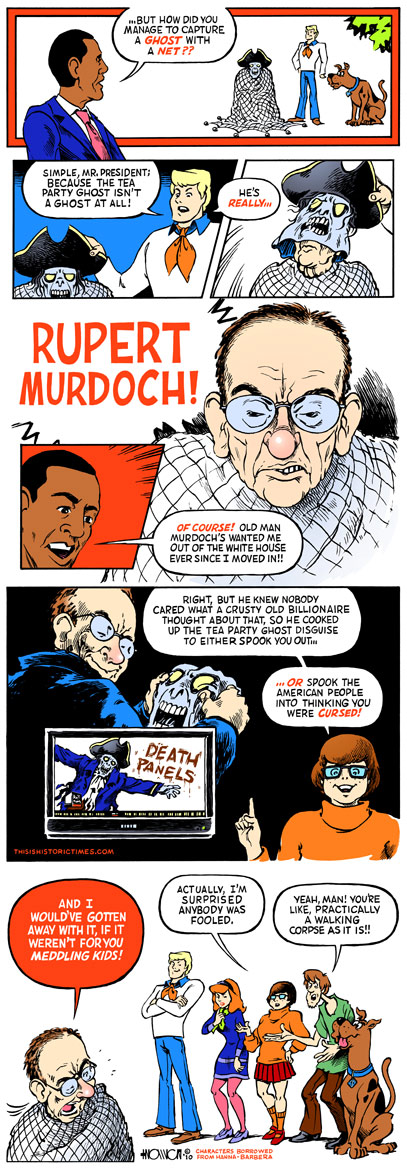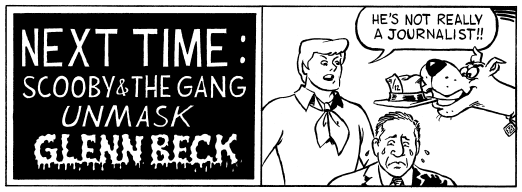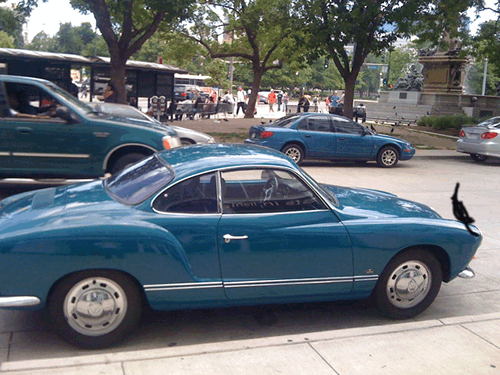Given that the United States’ health care reform bill has passed, I thought it would be a good time to share this great “Scooby-Doo” parody created by Terrence Nowicki:

Nowicki even included a bonus comic:

Given that the United States’ health care reform bill has passed, I thought it would be a good time to share this great “Scooby-Doo” parody created by Terrence Nowicki:

Nowicki even included a bonus comic:

“Your chair is your enemy,” starts the New York Times article Stand Up While You Read This!
To give you the thesis of the article, here are the next two paragraphs in the article:
It doesn’t matter if you go running every morning, or you’re a regular at the gym. If you spend most of the rest of the day sitting — in your car, your office chair, on your sofa at home — you are putting yourself at increased risk of obesity, diabetes, heart disease, a variety of cancers and an early death. In other words, irrespective of whether you exercise vigorously, sitting for long periods is bad for you.
That, at least, is the conclusion of several recent studies. Indeed, if you consider only healthy people who exercise regularly, those who sit the most during the rest of the day have larger waists and worse profiles of blood pressure and blood sugar than those who sit less. Among people who sit in front of the television for more than three hours each day, those who exercise are as fat as those who don’t: sitting a lot appears to offset some of the benefits of jogging a lot.
There are two reasons that sitting all day is bad for you:
If you’re self-employed, a mobile worker or have an understanding manager, you can take frequent breaks to do something out of your chair. As a Developer Evangelist with Microsoft, I’m a mobile worker and have taken advantage of the arrangement to do things like:
It’s worked out pretty well so far; since joining Microsoft, I’ve lost about 12 pounds.
But what if you’ve got an urgent project? Those interruptions are deadly to the sort of “flow” you need to get complex tasks done. One answer might be a “stand up” workstation, where the desk is mounted high enough so that you can use it in the standing position. A more extreme solution is the one pictured at the top of this article – yes, that things is real – Steelcase’s “Walkstation”, a workstation with integrated treadmill. Not only do you get some exercise while you work, the more poetic of you can treat it as an in-your-face metaphor for corporate life below the VP level.
You might not think that a physician-delivered lecture would be interesting viewing, but I’m having trouble pulling myself away from this presentation from University of California, San Francisco’s Osher Center for Integrative Medicine, Sugar: The Bitter Truth. In the presentation, Dr. Robert H. Lustig argues that fructose – especially in the form of high-fructose corn syrup – is so bad for you that it should be classified as a poison; he also likens the way your body reacts to it as alcohol without the buzz.
According to Dr. Lustig, it’s not merely an issue of biochemistry but also industry – he points to the corn industry-sponsored Sweet Surprise site – and even politics. He puts some of the blame on this guy, whom he alleges wanted to make food a non-issue in presidential elections:

(“Everything bad that ever happened in this country started with this man,” he quips when he shows the slide.)
The presentation is just under an hour and a half, but the presenter and topic are so interesting that you won’t notice the time pass. It gets a little science-y in places, but no more so than a Discovery Channel science program. It’s been broken into 9 ten-minute segments, which means you can spread out your viewing over a week’s worth of breaks.

The picture below is a very clumsy approximation of what my vision is going to be like for the next little while:

(And no, that’s not my Karmann Ghia. I wish it was, but it ain’t.)
That thing bobbing around the right side of the photo above – the black clump that looks like a bunch of knotted-up string or a very small rotten banana – is my rendition of the floater currently bobbing about in my right eye. The motion isn’t as jerky as the animation shows; it’s much smoother, like a dead ant in a jar of baby oil that occasionally gets shaken about.
The floater appeared last Wednesday. It slowly travelled from right to left and I swatted at it. That’s when I realized that it was actually a little object in my eye.
I’ve got a strong family history of retinal detachment. That’s when the retina – the paper-thin sensor at the back of your eyeball that catches light and turns it into electrical signals to be interpreted by your brain – comes loose. It’s common among nearsighted people, whose eyeballs are stretched so that the lens focuses light in front of the retina instead on on it:

If you’re nearsighted, it typically gets worse as you get older and your eyeball stretches. This stretching pulls the retina taut, making it more susceptible to tears or holes, which let the vitreous (the clear goo in your eyeball) seep underneath, causing your retina to peel away like wallpaper in a sauna.

To complicate matters, the vitreous also shrinks as you get older, and it pulls on the retina as it does so.
Floaters are a sign of possible retinal detachment, so I was a little concerned.
My original plan was to go to St. Joseph’s Health Centre, which is nearby and where they know me – my Mom’s the chief of cardiology there, and my brother-in-law also a cardiologist there. I figured it was best to go to a place where I had a little clout.
My brother-in-law suggested that I go to Toronto Western Hospital instead, since they are a big opthalmology hospital and would probably have an opthalmologist on call. The Ginger Ninja and I headed there, and sat in emergency, waiting to go through the Harry Potter Sorting Hat of triage.
Luckily for me, my mother and sister (she’s a doctor too) decided to come to the hospital. My sister prevailed on the emergency doctor (a PGY1 or “Piggy 1”, barely a couple of weeks into her first year of residence), who was going to send me home and have me come back in the morning. Our family has a history of retinal detachments progressing quite quickly, so the sooner my eye got looked at, the better.
While we waiting in the emergency examining room, I could hear a couple of family arguments in the adjoining areas. Emergency rooms often bring out the Jerry Springer guests in people.
In the end, the opthalmological resident, Dr. Mandell, gave me a full exam – including poking at my eye with a metal stick – and found a couple of small holes in my retina.
“They’re tiny holes, but we can use a laser to seal them so that your vitreous doesn’t leak under them, which will eventually cause a detachment. The vitreous is tugging at your retina a little; I can tell from the tenting.”
I resisted the urge to go all Beavis and Butt-Head and say “Huh-huh-huh, you said ‘tenting’.”
It was after the clinic’s hours, so we had to wait for a security guy to open the locked room where the laser lenses were stored. While Dr. Mandell was going about trying to get his hands on the lenses, Wendy took this photo of me on her phone:

The laser was computer-controlled, and guess what it ran:

“Win2K? I’ve got some Windows 7 discs,” I joked with Wendy. “Maybe I can upgrade him before he comes back.”
The procedure involved my holding my head very still in the headrest. Dr. Mandell held a lens covered with goop to my eyeball, through which he focused a laser to do the retinal spot-welding.
“Keep your head still,” he said. “You don’t want the laser to hit the wrong thing.”
“No, I don’t,” I said in agreement.
All I saw was about ten seconds of a bright flashing green light. Then another ten seconds. Then another ten seconds, after which he said “All done.”
There’s only one thing the laser couldn’t fix:

I was told that it would eventually dissolve…”in weeks, perhaps months.”
It’s only slightly annoying when I’m looking at things that are an arm’s length away or farther. When I focus on objects at those distances, the floater becomes a blurred-out grey region and isn’t too hard to deal with. Reading, using the computer and driving aren’t really affected by it.
However, when I focus on objects close by, the floater comes sharply into focus and it seems as though I’m viewing the world through the aforementioned jar of baby oil with a dead ant floating in it. I noticed this when looking through my camera’s viewfinder. Any career aspirations to become a sniper, astronomer, diamond merchant or anything that requires me to look through a viewing lens will have to be put on hold.
Since I’m going to be stuck with this thing for a while, I might as well have some fun with it. I should give it a name. And that’s where you come in. I’m taking suggestions for names in the comments, and whoever comes up with the best name will get at $25 ThinkGeek or Amazon gift certificate from Yours Truly.
And no, “Floaty” is not a good name. Get creative!

Since getting laid off, I’ve been getting a little less exercise. My bike commute to work, a 14-kilometre (8.7 mile) round trip, is gone. I also haven’t been going to the gym as often, even with the extra free time. I’ve lost five pounds since getting called into my layoff meeting two weeks and two days ago, in spite of the reduced exercise and some pretty big meals, including an anniversary dinner, Wendy’s birthday dinner and the farewell dinner b5 threw earlier this week. I needed to shed that weight anyway; I should make sure not to gain it back once I land a job.
Should you lose your job, your mileage may vary depending on how you respond to stress. I’ve been waking up about an hour earlier than normal to work on my career plans, research the companies who’ve shown an interest in me, and to do a little extra work on some blog entries. I also haven’t felt like eating as much, which comes from feeling twitchy about the situation. If your response to stress is to eat more or drink lots of beer (a.k.a. “liquid bread”), the change in your weight is likely to be the opposite of mine.